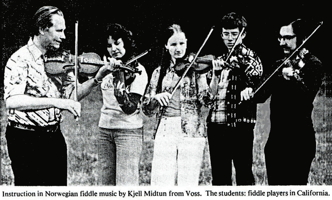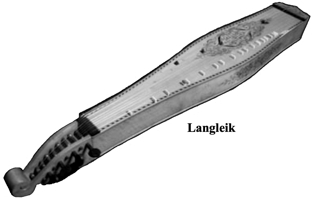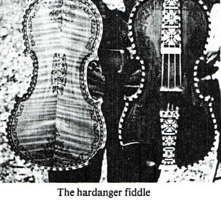
|
The Society of Folk Dance Historians (SFDH)
Folk Dance in Norway
[
Home |
About |
Encyclopedia | CLICK AN IMAGE TO ENLARGE |

|
 Dancing has been part of the Norwegian culture since ancient times, and as the times have changed, so the dances have changed. Since the days of the Vikings, Norwegians have travelled widely and have been active in the 'trade' of music, dance, and other customs. Throughout the centuries, foreign influences in both music and dance have helped to shape Norwegian dance forms. As new dance steps and figures were assimilated into Norwegian communities they acquired a distinct Norwegian flavor and a characteristic local dance style. What we commonly call 'Norwegian folk dance' today is a collection of dances that have evolved over the past three to four hundred years.
Dancing has been part of the Norwegian culture since ancient times, and as the times have changed, so the dances have changed. Since the days of the Vikings, Norwegians have travelled widely and have been active in the 'trade' of music, dance, and other customs. Throughout the centuries, foreign influences in both music and dance have helped to shape Norwegian dance forms. As new dance steps and figures were assimilated into Norwegian communities they acquired a distinct Norwegian flavor and a characteristic local dance style. What we commonly call 'Norwegian folk dance' today is a collection of dances that have evolved over the past three to four hundred years.
The oldest dance form in Norway is the song dance which accompanies a ballad. In France and England this form became known as the carol. It is believed that this medieval dance form dates back to the twelfth century in Norway. Some of these old Norwegian ballads have themselves common to ballads from abroad. Others have their roots in the Skáldic poems which the skálds (bards) recited before kings and chieftains. Unique to many of the Norwegian ballads are descriptions of the trolls and the fights between the people and these dwarf-like, hostile beings. Ballads often tell the story of a young maiden spirited off into the mountains to be the wife of a mountain king; or the story of the trolls bewitching the king's daughter into Trollbotn, a great bay in the far North where, according to popular belief, the trolls lived. The hero in these ballads engages in fierce fights to free the maiden from her evil captors. Detailed descriptions of the battles that are fought are often the main content of these ballads.
In the song dance, the ballads are sung while dancing in a line moving to the right. The men and women join hands at shoulder height and perform a simple step (such as the Bulgarian pravo) accompanied by their own singing. These dances are best performed in a confined area where the singing, stamping, and massed bodies fill the space, intoxicating the dancers who go on for hours.
The song dance was a drastic and strong dance form which persisted into the seventeenth century throughout Norway and probably the rest of Scandinavia as well. As the influence from abroad increased through trade, and because of the return of Scandinavian mercenaries from the European wars, new dances arrived and musical instruments became more common. The pols dances from Poland, court dances from central Europe, and Scottish reels pushed the old-fashioned Norwegian ballads and song dances farther and farther up into the mainland of Norway. They survived only in the isolated islands to the west where they are still danced to this day.
At the turn of the century these song dances gained a new popularity in Norway. Norwegians were fascinated by the songs (some of them still sung in ancient Norwegian) and the dances were still being performed by people from the Faro islands. Today, the song dance again has a solid place in the repertoire of many Norwegians.
During the time of the transition from song dances to dances performed to musical instruments, new styles emerged influenced by the Polish dances, the Moorish dances from England, the European court dances, and the old ballad dances from Norway. This melting together of many styles resulted in a great variety of dances developing in the isolated valley and fjord regions where the rugged countryside made communication from one valley to another valley very difficult. From the steep mountains, deep fjords and valleys in the west of Norway, to the rolling forested hills of the east, a great variety of dance styles and rhythms developed. Each area treasured its own special and unique form of music, song, and dance.
The song dances are what we call bygdedans (regional dances) today. They include the springar, gangar, pols, and vossarull. They are all couple dances and are somewhat complicated in both form and rhythm. They encourage a lot of individual 'showing off', mostly on the man's part. He must display his virility and strength, while the woman shows her feminine grace.
In the springar, the music is 3/4 time but heavily syncopated. Often the rhythmic pattern does not follow the melodic pattern which makes it very difficult for the untrained ear to follow. Although the music is 3/4 time, the dance steps may alternate between 2/4, 3/4, and 4/4 with syncopated phrases in between.
The gangar is common to Telemark and Setesdal and is one of the most aristocratic and stylish of the Norwegian dances. The rull, found in the area of Voss is related to the gangar through its music, but the dance style is quite different. Both the gangar and the rull can be danced to music in 2/4 or 6/8 time.
The eastern valleys of Norway have their pols and springleik – both dances in 3/4 time. The most popular of these dances is the rørospols (the pols dance from the region around the town of Røros). It is believed that the rørospols has been danced in its present form for more than four centuries by people living in eastern Norway and western Sweden. A tapestry from around the year fifteen hundred, preserved in the Gripsholm Castle near Stockholm in Sweden, displays a dance called bon-dans (peasant dance) which in every detail corresponds to the four dance positions used in the rørospols today. Perhaps it is this test of time that has made the rørospols such a delightful and exhilarating dance, now enjoying immense popularity throughout Norway.
![]()
 Just as the import of European dances into Norway influenced the evolution of folk dance, so did the arrival of new musical instruments. The oldest Norwegian folk instrument was the lur, a wind instrument of wood and birch bark. This instrument was used by shepherds both for communication and for frightening predators away from their livestock. Later, the willow pipe, rams's horn, and bagpipe came into use. The langeleik, a dulcimer-like instrument dating back to about fifteen hundred, was one of the first stringed instruments before the fiddle arrived in Norway during the seventeenth century. Soon after its arrival, the fiddle became the most commonly used instrument for both listening and dancing music.
Just as the import of European dances into Norway influenced the evolution of folk dance, so did the arrival of new musical instruments. The oldest Norwegian folk instrument was the lur, a wind instrument of wood and birch bark. This instrument was used by shepherds both for communication and for frightening predators away from their livestock. Later, the willow pipe, rams's horn, and bagpipe came into use. The langeleik, a dulcimer-like instrument dating back to about fifteen hundred, was one of the first stringed instruments before the fiddle arrived in Norway during the seventeenth century. Soon after its arrival, the fiddle became the most commonly used instrument for both listening and dancing music.
 Today, the fiddle is undoubtedly the folk instrument of Norway, especially for dancing. In the eastern and northern parts of the country the regular fiddle is most common, but the western and southern parts have the eight-string hardangar fiddle. The hardangar fiddle, in addition to its regular four strings, has four sympathetic under strings that provide a rich quality to the sound. Double and even tripple stops are commonly used by hardangar fiddle players making it sound as if there are several instruments playing simultaneously. A tremendous wealth of fiddle tunes exists among Norwegian fiddle players. Many of the best-known fiddle players are also excellent teachers, and today the number of good folk musicians is increasing. An unforgettable experience in music and dance is to attend a competition where several hundred fiddlers play.
Today, the fiddle is undoubtedly the folk instrument of Norway, especially for dancing. In the eastern and northern parts of the country the regular fiddle is most common, but the western and southern parts have the eight-string hardangar fiddle. The hardangar fiddle, in addition to its regular four strings, has four sympathetic under strings that provide a rich quality to the sound. Double and even tripple stops are commonly used by hardangar fiddle players making it sound as if there are several instruments playing simultaneously. A tremendous wealth of fiddle tunes exists among Norwegian fiddle players. Many of the best-known fiddle players are also excellent teachers, and today the number of good folk musicians is increasing. An unforgettable experience in music and dance is to attend a competition where several hundred fiddlers play.
The fiddle, and later the accordion and clarinet were used to accompany the turdansar (figure dances) that became popular in Norway during the last century. This dance form includes set dances, contra dances, and reels that represent the most recent inports from neighbors to the south of Norway and from the British Isles. Although the dances bear close resemblance to the stylish European court dances of the eighteenth and nineteenth centuries, the Norwegians have added a lot of their own flavor. Traditional fiddle tunes were adapted and a great number of new tunes were composed to fit these new dances. During this time, many new couple dances came to Norway, such as the waltz, polka, rhinelander, and others. These are among the dances that are commonly called gammaldans (old-time dances). Both these old-time dances and the traditional dances (song dances and regional dances) have gained in popularity since about 1967. Whereas ten to twenty years ago these dances were performed only by organized folk dance groups, it is now quite common to see people enjoying these dances at a party or at the local dance hall on a Saturday night.
Since 1967, Norwegian as well as other Scandinavian folk dances have gained tremendous popularity among American folk dancers. One may wonder how well these rather complicated dances can be learned in a situation far removed from the environment where they evolved. This is not only a concern among the teachers of Scandinavian folk dance in the United States, but the Norwegians themselves are concerned about the preservation of their traditional styles.
In Norway, the uniqueness of these dances came about as a result of limited communication with the outside world. There was ample time for the dances to evolve in the relatively isolated Norwegian communities. Today, there is a television set in almost every household and airplanes in the most remote communities of a highly developed country. The Norwegians continue to make a tremendous effort to maintain their local dance forms, coustoms, dialects, and music.
Among American folk dancers, unfortunately, the value is often on the quantity and not the quality of dances in their repertoire. This is a sure way of shortchanging oneself of the pleasure of dancing. The student of Norwegian folk dance will find that even after many years of practicing a dance, there are always new subtleties to be discovered and enjoyed. The great variety of music available for each dance is also a source of pleasure in dancing that must be explored.
Above all, the couple dances from Norway are a social experience. One has to make it work with another person. At the beginning, this may be as much a frustration as it is a pleasure, but once accomplished the rewards make the initial difficulties look like a small price to pay. After learning the dance well, one can have a delightful experience on the dance floor, sharing the dance with a special partner.
Ingvar Sodal was born in Norway and has been involved with Scandinavian dance since his teens. He has been an instructor at many camps and workshops throughout the United States.
Used with permission of the author.
Printed in Balkan Arts Traditions, Vol. III, Number 1, 1977.
DOCUMENTS
- About Norway, Article.
- Historical Notes on the Norwegian Rørospols, Article.
- Norwegian Dance, Article.
- Norway, A country.
- Centre of the Norwegian Council for Folk Music and Folk Dance, Article.
This page © 2023 by Ron Houston.
Please do not copy any part of this page without including this copyright notice.
Please do not copy small portions out of context.
Please do not copy large portions without permission from Ron Houston.